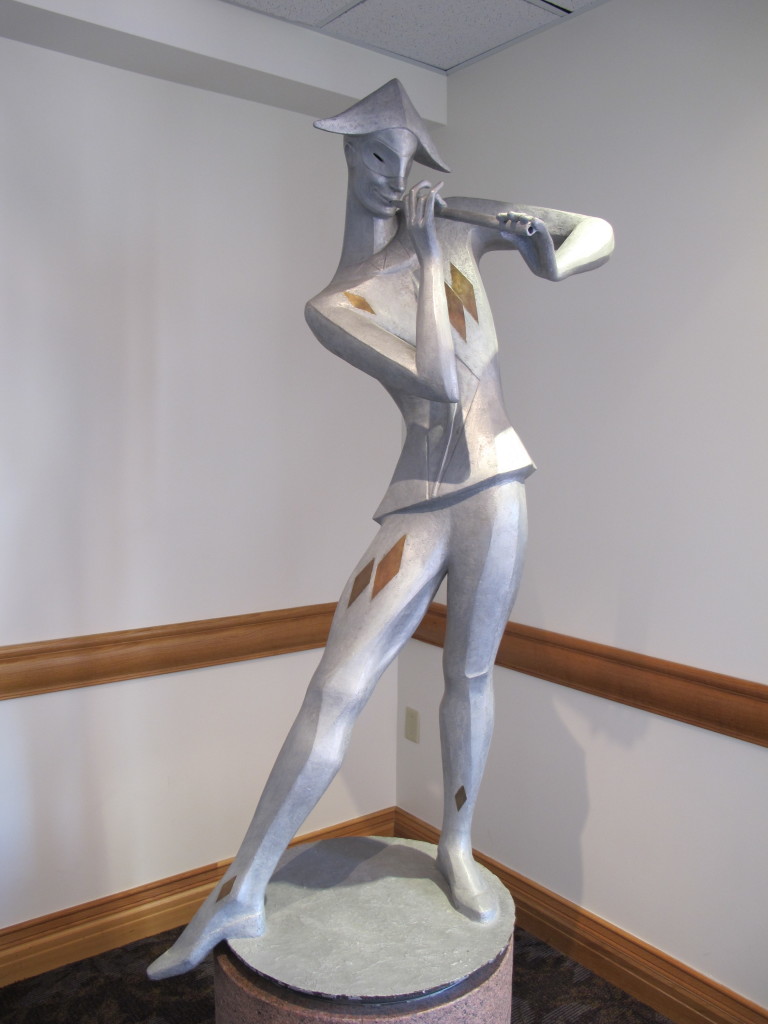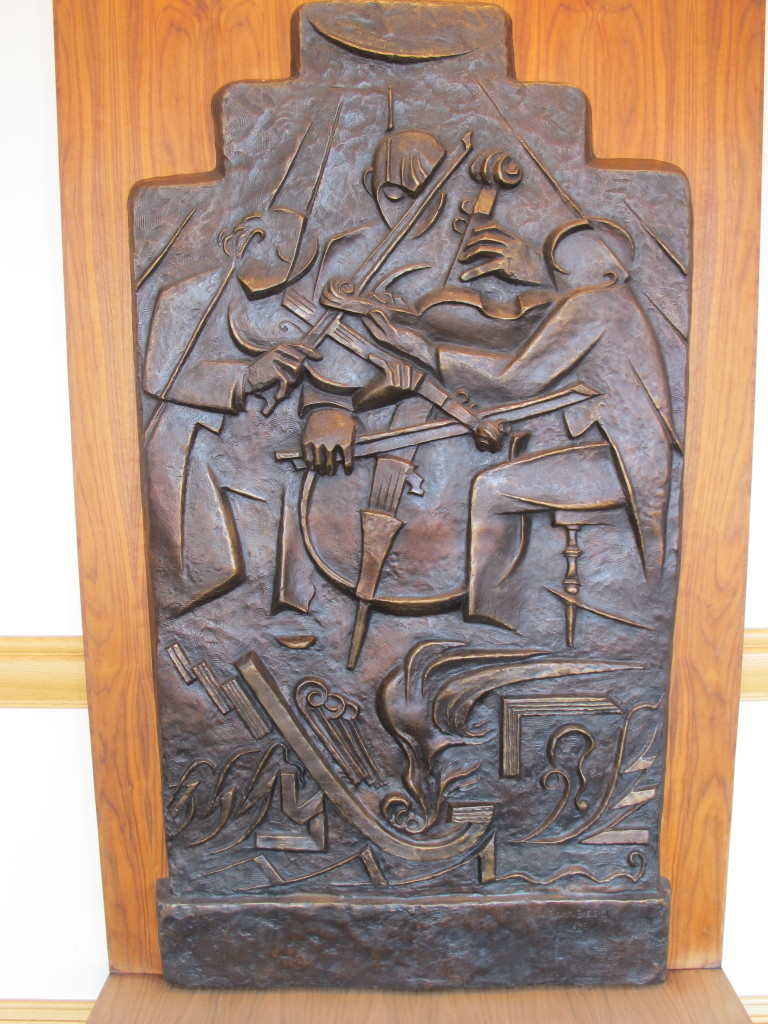Harlequin: Performance & Play

Marion Buchan (1895-1971), Harlequin, 1957, Aluminum-filled plastic putty over steel armature, 61 x 28 1/2 x 21 in.
Location: Inside West Entrance
- Harlequin was one of several near life-size treatments of the subject by Buchan, who was Assistant Professor of Drawing and Painting at DU’s School of Art from 1944-1958.
- This version was commissioned by Campton Bell, Theatre Department chairman, around 1957. In 1993, it was removed from the lobby of the Lamont School of Music, which was then located in Denver’s Park Hill neighborhood.
- Though it looks like it was constructed of shiny metal, it actually was made of metal-filled apoxy. Thus, it was not intended to be an outdoor piece, and over time lost fingers and most of the flute.
- Harlequin was professionally restored in 2002 through the efforts of Annette Stott and Buchan’s granddaughter, Holly Buchan, and prepared for long-term installation at the Robert and Judi Newman Center for the Performing Arts. Its placement near both the Byron Theater and Hamilton Recital Hall is fitting given the sculpture’s themes of music and theater, therefore preserving the sculpture’s original connections.

Arnold Rönnebeck, Trio and Tone Shapes, 1938-39, bronze cast no. 1 of 2
Location: inside west entrance of the Newman Center
A group of sculptural works created between 1938 and 2003 ornament the Newman Center for the Performing Arts at the southeast corner of the campus. Works in the west lobby by faculty members Arnold Rönnebeck (1885-1947; Trio and Tone Shapes, 1938-39) and Marion Buchan (1895-1971; Harlequin, 1957) visually portray the performing art of the string trio and the “Commedia dell’arte,” respectively. Both sculptures were the subject of restoration campaigns during the past decade, and the first-ever bronze casting of Rönnebeck’s Trio and Tone Shapes was completed in 2007.
The performing arts themes continue on the exterior of the building with low-relief sculptures in limestone by the artist team of Kathi Caricof (b. 1957) and Madeline Wiener (b. 1947). Porch Performers (2003), just outside the west entrance, continues the Commedia theme, portraying the antics of Harlequin, Pantalone and Colombina. On the south façade, The Spirit of Music (2003) includes two groups dedicated to jazz and classical music.
Another important work devoted to the performing arts is currently undergoing a multi-year restoration effort. The “Shakespeare Mural” was completed in 1929 by faculty member and leading regional painter John E. Thompson (1882-1945) to ornament the Little Theatre of Margery Reed Hall. Featuring scenes from five plays of Shakespeare, it was painted over in 1931 by Walter Sinclair, incoming chairman of the Theatre Department. Unfortunately, similar acts of destruction befell other major works on campus.
Click HERE to return to the Campus Art Highlights page
View Living Memory DU in a larger map
——-
DU Art! Art Walk Training:
STOP: NEWMAN CENTER (5 MINUTES INSIDE)
Arnold Rönnebeck [1885-1947), Trio and Tone Shapes, 2007, Bronze cast no. 1 of 2
Location: Inside West Entrance
- RECAPTURING THE PAST
- Arnold Rönnebeck was Instructor in Sculpture at the School of Art from 1929-1935. Trio and Tone Shapes was an unrealized 1939 commission for a Denver Public Schools auditorium. A 1968 account by Vance Kirkland, then director of DU’s School of Art, indicates that the piece was rejected by DPS as “too modern.” The sculpture captures a certain spirituality through the inclusion of signs and symbols and the influence of Native American art of the Southwest (lightning).
- The relief was retrieved from the Hosek Manufacturing Company by Kirkland in 1968 and incorporated into the University’s art collections. The 2007 casts were taken from the painted plaster original, which was too fragile to be displayed in its original form.
- The remaining bronze resides in the collection of Denver’s Kirkland Museum of Fine and Decorative Art. The relief was cast at the Fedde Bronze Works, Denver.
- University is now making a concerted effort to highlight former faculty members. Regain the visual art memory of the campus.

Leave a Reply